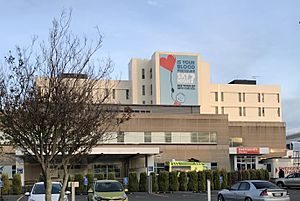Palmerston North Hospital facts for kids
Quick facts for kids Palmerston North Regional Hospital |
|
|---|---|
| MidCentral District Health Board | |

Palmerston North Regional Hospital main building, May 2020
|
|
| Geography | |
| Location | Palmerston North, Manawatū-Whanganui, New Zealand |
| Coordinates | 40°20′19″S 175°37′13″E / 40.3387°S 175.6203°E |
| Organisation | |
| Funding | Public hospital |
| Hospital type | General |
| Services | |
| Emergency department | Yes |
| Helipad | (ICAO: NZJM) |
| Beds | 354 |
Palmerston North Regional Hospital is a very important hospital in Palmerston North, New Zealand. It is the main public hospital for the city. You can find it at the northern end of Ruahine Street. It is about 2 kilometers northeast of The Square, which is a well-known spot in Palmerston North.
The hospital is run by the MidCentral District Health Board. This board helps people in Palmerston North and nearby areas. These areas include the Manawatū, Tararua, and Horowhenua districts. As of 2020, the hospital has 354 beds for patients who need to stay overnight. It is also a major trauma center. This means it is set up to handle very serious injuries. It is one of four such centers in the lower North Island. The others are Hawke's Bay Hospital, Whanganui Hospital, and Wellington Regional Hospital.
Contents
Hospital's Early Days
The hospital first opened its doors a long time ago, on 27 November 1893. When it started, it had 25 beds for patients. These beds were spread across four different rooms, called wards. Only two doctors and three nurses worked there at the beginning.
First Registered Nurse
A special person named Ellen Dougherty was the hospital's first matron. A matron is like a head nurse. On 10 January 1902, Ellen Dougherty became the world's first registered nurse. This happened after New Zealand Parliament passed a law called the Nurses Registration Act 1901. This law made sure nurses had proper training and qualifications.
Special Medical Discovery
In 1968, doctors at the hospital learned something new about a rare genetic condition. This condition is called malignant hyperthermia (MH). It is a genetic disorder that can cause a severe reaction in some people. This reaction happens when they are given certain medicines used during surgery.
Understanding Malignant Hyperthermia
Doctors later found out that many people in the Manawatū region had the gene for MH. Because of this, Palmerston North Regional Hospital sees more patients with this condition than most other hospitals. About one in every 200 surgeries at this hospital involves a patient who might have MH. This is much higher than the worldwide average.
Testing for the Condition
To help with this, New Zealand's first and only MH testing center was set up. It started at Massey University in 1978. Then, in 1986, the hospital's own anaesthetic department took over the testing center. This means they can test people to see if they have the MH gene. This helps doctors keep patients safe during operations.
Recent Hospital Improvements
In early October 2024, the New Zealand Government gave NZ$6 million to Palmerston North Hospital. This money was given to help make things better for patients. It was used to improve how long people wait in the emergency department. It also helped to make patient care and other services better at the hospital.

